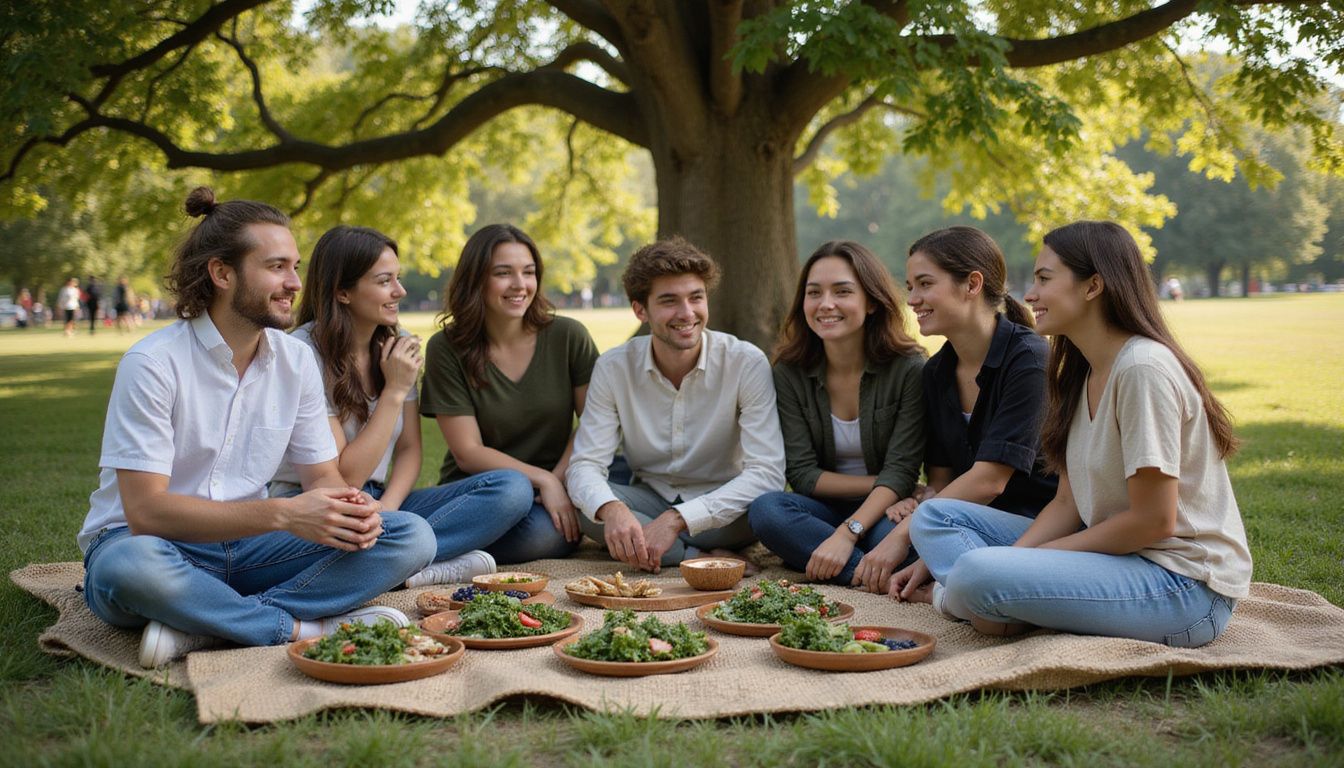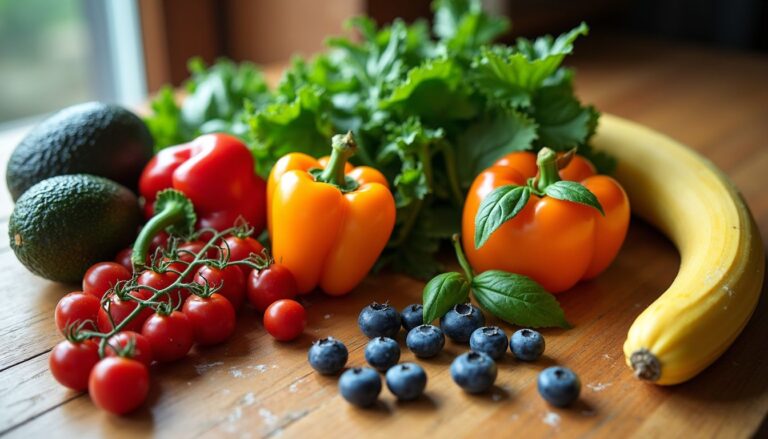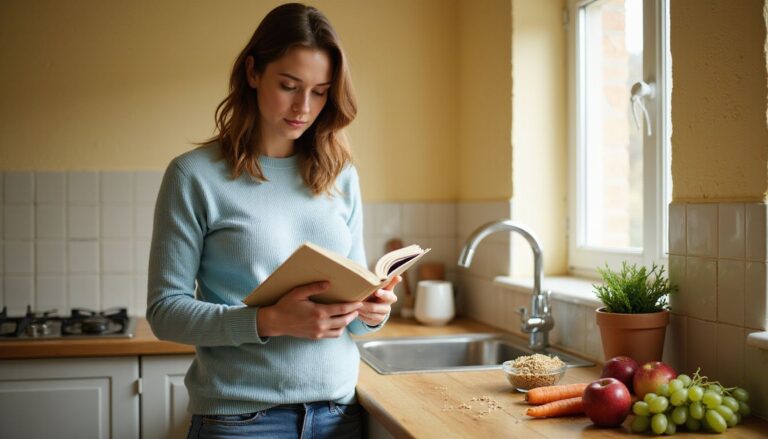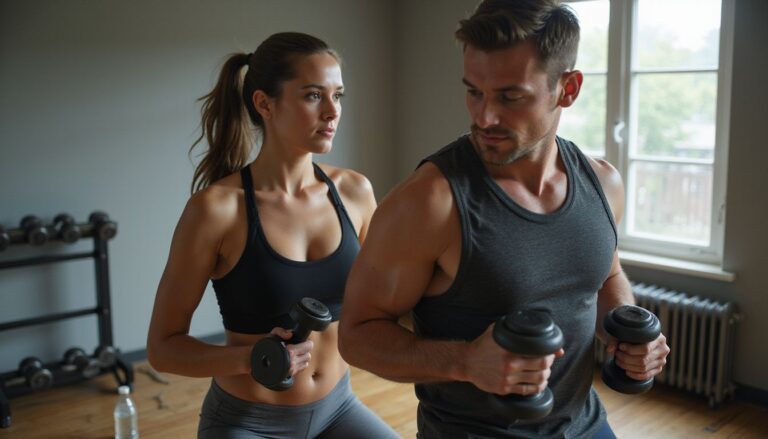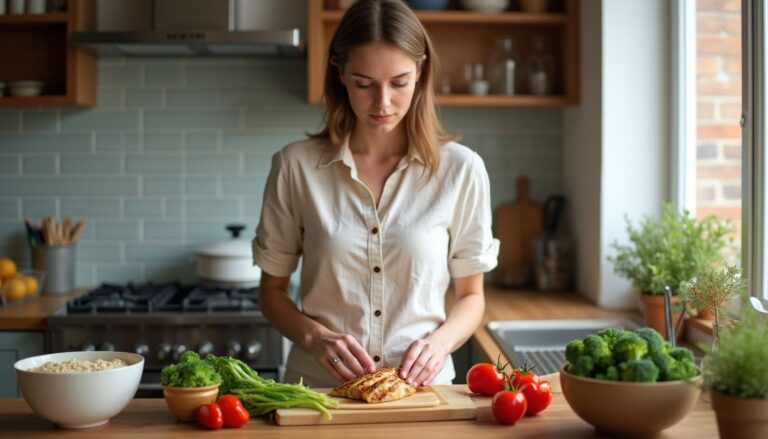10 Delicious Low Calorie Lunch Ideas For A Healthy Diet
Our Nutrition Assistant AI Suite will transform your body. You will lose fat, get toned, and build muscle. Gain confidence and optimal health.
Feeling stuck eating the same lunch every day? You are not alone. Choosing low calorie lunches can cut daily calories and still keep flavor high.
This guide shares ten easy, tasty ideas that travel well for work or school. Each low-calorie lunch recipe is simple to prep and satisfying to eat.
Key Takeaways
- Target 300 to 500 calories for lunch to support weight goals. The CDC notes that trimming about 500 calories per day can lead to roughly one pound lost per week.
- Lean protein, like chicken or tuna, plus whole grains, such as quinoa, help manage hunger and steady your afternoon energy.
- Using portion control containers can help reduce calorie intake by up to 22 percent, based on a 2018 Journal of Nutrition Education study.
- Swap creamy sauces for vinaigrettes and load up vegetables. You add nutrients and flavor while keeping fat and sugar in check.
- Low-cal lunches fit many eating styles. People with health conditions should talk with a healthcare professional before major changes, per the U.S. Dietary Guidelines 2020–2025.

Benefits of Low-Calorie Lunches
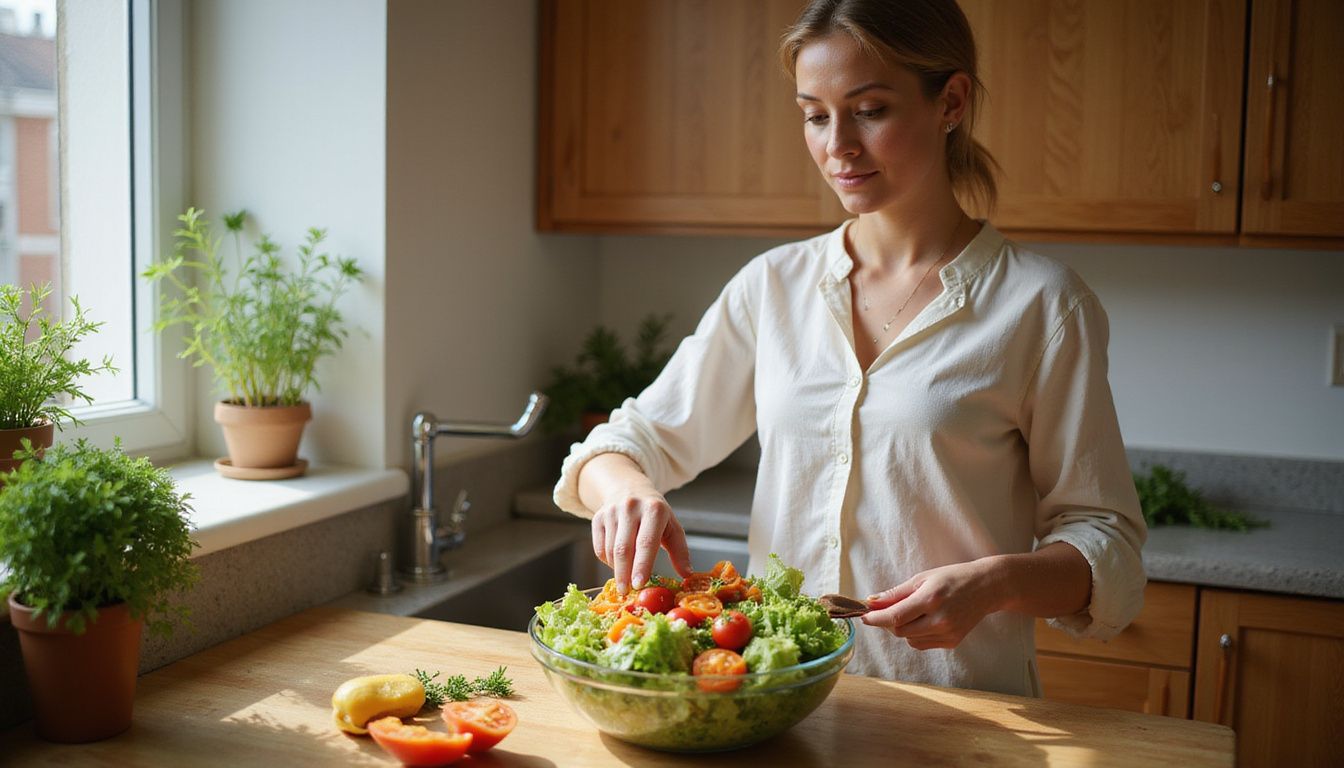
Low-calorie lunch recipes help you manage portions and keep midday meals light. Many include protein and fiber, which support steady energy and fewer cravings.
How do low-calorie lunches support weight management?
Keeping lunch near 400 to 500 calories controls intake without leaving you hungry. This range supports weight goals while fueling your afternoon.
The CDC reports that cutting about 500 calories daily may lead to a loss of about one pound per week. Choices like lettuce wraps, veggie and hummus sandwiches, and chickpea salads are filling with fewer calories from fat and sugar.
Build plates around lean protein, whole grains, and colorful vegetables. Chicken breast, tuna, or tofu can curb afternoon snacking. Whole foods are satisfying and help you stay on track.
Fiber from lentils, black beans, and brown rice helps you feel full longer. Trade creamy dressings for vinaigrettes to reduce hidden calories without losing taste.
Why do low-calorie lunches keep you energized all day?
Balanced, lighter lunches support focus. Pair lean protein with whole grains like quinoa or brown rice and plenty of vegetables for steady fuel.
These foods digest slowly and help prevent blood sugar dips. Heavy fried foods or creamy pastas often do the opposite and can make you sleepy.
High fiber meals, such as spinach salads, chickpea sandwiches, or zucchini noodles, support lasting fullness. Research in The American Journal of Clinical Nutrition links higher protein lunches with more stable afternoon energy^1^.
Foods rich in complex carbs, like sweet potato salad or couscous, release glucose at a steady rate. You avoid spikes that drain focus during work or class.
Balanced low-calorie lunches provide the nutrients needed for steady performance without an afternoon slump.
Grilled chicken salad, roasted red pepper hummus wraps, and veggie soups fit well into meal prep. They offer flavor and stamina for busy days.
^1 Leidy HJ et al. Protein intake improves appetite control and satiety. Am J Clin Nutr. 2015;101(3):684-692.
What essential nutrients are found in low-calorie lunches?
Low-calorie lunches can deliver protein, fiber, vitamins, and minerals while keeping portions in check. Common protein picks include chicken, tuna, eggs with tomatoes, and chickpeas.
Vegetables like broccoli, bell pepper, lettuce, cucumber, and spinach add vitamin C, potassium, iron, and antioxidants. They also add volume for few calories.
Whole grains, such as quinoa and whole wheat bread, bring fiber that supports digestion and fullness. Healthy fats from avocado or olive oil boost flavor and heart health in small amounts.
Tips for Preparing Low-Calorie Lunches
Smart swaps make low-cal lunches easier to prep. A few habits keep flavor high while holding lunch near 400 calories.
Why focus on lean proteins for low-calorie lunches?
Lean proteins keep you satisfied with fewer calories. Chicken, turkey, eggs, tuna, and salmon provide amino acids, the building blocks that help repair muscles.
A 3 ounce cooked chicken breast has about 26 grams of protein and roughly 140 calories per serving. Choosing lean cuts means less saturated fat than fattier meats or heavy cheeses.
High protein meals often control hunger better than meals high in carbs or fat alone. Research supports this effect[^1]. “Protein is the most filling macronutrient,” says registered dietitian Susan Bowerman.
Focusing on lean protein options helps support weight management goals while keeping your lunch both hearty and satisfying.
Pair protein with vegetables for extra nutrients and crunch without many calories.
[^1]: Paddon-Jones D et al. Protein, weight management, and satiety. Am J Clin Nutr. 2008.
How can I include more vegetables in my low-calorie lunch?
Add sliced cucumbers, bell peppers, carrots, or cherry tomatoes to sandwiches or wraps. These crunchy vegetables add volume with very few calories.
Stir sautéed spinach or kale into an easy pasta salad for fiber and vitamins. Try an egg salad lettuce wrap with celery, pickled cucumber, onion, and shredded carrot mixed with mustard and Greek yogurt.
Roast zucchini, red onion, and chili pepper with black pepper and a little olive oil for a warm side. Include spaghetti squash or sweet potato cubes in grain bowls as light bases.
Keep pre-cut vegetables like cabbage slaw ready in the fridge. A cup of tomato soup on the side adds more vegetables while keeping lunch light.
What whole grains add fiber to low-calorie lunches?
Brown rice, quinoa, whole wheat bread, and barley are great fiber sources. One cup of cooked quinoa has roughly 5 grams of fiber and is gluten free.
Cooked oats can anchor a savory bowl with about 4 grams of fiber per cup. Leftover brown rice works well in a quick vegetable stir fry with a splash of teriyaki.
Whole grain wraps or pita offer grab-and-go convenience. Pair them with lean proteins and crisp vegetables for balanced meals.
These grains support digestion and steady energy. Once fiber is covered, lighten sauces to keep calories low.
How do I avoid high-calorie dressings and sauces?
Pick vinaigrettes made with vinegar, lemon, or lime instead of creamy dressings like ranch or mayonnaise. Mix your own with olive oil, mustard, garlic, herbs, and citrus.
Use Greek yogurt in chicken salad or submarine sandwiches to replace mayo. Add basil or dill for flavor without extra calories.
Some store-bought dressings labeled “light” can work, but check serving sizes. Use less parmesan or butter. Salsa, hot sauce, or roasted red pepper hummus can add a big flavor lift with few calories.
These dressings match well with veggie and hummus sandwiches or quinoa chickpea salads for satisfying, lighter meals.
10 Delicious Low-Calorie Lunch Ideas
These lunch ideas are fast, flavorful, and travel well. Pick a few for your weekly rotation and keep your low-calorie meal plan fresh.
What are some tasty low-calorie egg salad lettuce wrap recipes?
Trade bread for large leaves of romaine or butter lettuce. Mix chopped hard-boiled eggs with a little light mayo or nonfat Greek yogurt, mustard, diced pickles, dill, salt, and black pepper.
For extra protein, add diced grilled chicken or sprinkle a little feta. Pile the egg salad into crisp lettuce and top with thinly sliced radish, cucumber, or shredded carrots.
Add a pinch of chili flakes for heat. Each wrap lands around 120 to 140 calories if you use two eggs and avoid heavy dressings.
This option is gluten free and vegetarian if you skip meat add-ins. Pack in a lunchbox or mason jar and keep chilled.
How do I make a veggie and hummus sandwich?
Spread two tablespoons of hummus on whole grain bread or toast for fiber. Layer sliced cucumber, tomato, spinach, and shredded carrots.
Add roasted bell pepper strips for a sweet, smoky note. Keep the sandwich under about 170 calories per serving by watching spreads.
Season with a little salt, pepper, or a squeeze of lemon. Swap in grilled zucchini or pickled vegetables when you want variety. It takes less than ten minutes to make and keeps energy steady.
How to prepare quinoa chickpea salad with roasted red pepper hummus dressing?
Cook quinoa as directed, then cool. Rinse and drain canned chickpeas for plant protein and fiber. Chop cucumbers, tomatoes, and parsley for freshness.
Blend roasted red peppers with hummus, lemon juice, and a small spoon of mustard for a tangy dressing. Toss cooled quinoa with vegetables and chickpeas.
Coat with the hummus dressing and serve warm or chilled. It tends to be lower per serving than many pasta entrées and is naturally gluten free and vegan with certified ingredients.
What is a healthy recipe for lemon chicken pasta?
Use grilled or pan-seared chicken breast, whole wheat noodles, and vegetables like spinach and cherry tomatoes. Toss with fresh lemon juice for bright flavor without heavy sauces.
Add chopped parsley and cracked black pepper. Use a little olive oil in place of cream or butter.
Cook pasta until al dente, about 8 minutes or less. Season the chicken lightly with mustard and pepper, then combine while warm so flavors meld.
This high protein entrée is ready in under 30 minutes and fits calorie restriction goals.
How do I make a chickpea salad sandwich?
Mash canned chickpeas with a fork. Stir in diced celery, red onion, and shredded carrot for crunch. Mix with plain Greek yogurt or vegan mayo for a creamy texture with fewer calories.
Season with Dijon mustard, lemon juice, salt, black pepper, and chopped dill or parsley. Add a small pinch of chili powder if you like heat.
Serve on whole grain bread for fiber or use lettuce leaves for a gluten free option. Top with sliced tomato and cucumber to add color and nutrients.
Chickpeas are filling, with about 269 calories and 15 grams of protein per cooked cup [1]. This sandwich holds up well in a lunchbox during busy workdays.
[1] U.S. Department of Agriculture, FoodData Central, chickpeas cooked, 1 cup.
What ingredients go into a tuna and olive spinach salad?
Start with fresh spinach as the base. Add canned tuna packed in water for lean protein. Slice black or green olives for a salty bite that boosts satisfaction.
Include thin red onion slices and halved cherry tomatoes for crunch and vitamin C. Dress with a light mustard vinaigrette, made with Dijon, lemon juice, and olive oil.
Finish with black pepper or chopped parsley. It is a fast, healthy lunch that pairs well with a small whole grain roll.
How to prepare turkey BLT wraps?
Roast or grill lean turkey breast. Spread a very thin layer of mustard on a whole wheat tortilla. Add leafy lettuce, ripe tomato, turkey, and a strip of crisp bacon. Turkey bacon can lower fat and sodium further.
Roll tightly and slice in half. These wraps travel well and stay fresh until lunchtime.
For extra crunch, add cucumber strips. A small orange on the side brings fiber and vitamin C.
What is a nutritious sweet potato and lentil soup recipe?
Warm soup can still be light. Dice one sweet potato, rinse half a cup of dry red lentils, and chop one onion and two cloves of garlic. Use four cups of low sodium vegetable broth.
Sauté onion and garlic until soft. Add sweet potato, lentils, broth, one teaspoon smoked paprika, and a pinch of cumin. Simmer about twenty-five minutes until tender.
Stir in shredded carrot or zucchini for more vegetables. The soup provides around 11 grams of protein per serving, usually under 200 calories per bowl.
Keep it gluten free by skipping flour thickeners. A slice of whole grain toast on the side can add fiber.
How do I make a healthy chicken pasta salad?
Grill or bake skinless chicken breast with pepper and garlic powder. Cook whole wheat pasta and rinse in cold water.
Chop cucumbers, bell peppers, cherry tomatoes, and spinach. Combine chicken, pasta, and vegetables in a bowl.
Whisk nonfat Greek yogurt with mustard, lemon juice, pepper, and a pinch of salt for a light dressing. Toss until coated, then chill for one hour.
Add a spoon of toasted pumpkin seeds or a few sliced olives for texture. The salad stays light yet full of flavor.
What is a flavorful prawn sweet chili noodle salad recipe?
Toss cooked shrimp with rice noodles, sliced cucumber, and shredded carrot for a light, fresh base. Make a quick sauce with sweet chili sauce, lime juice, low sodium soy sauce, and minced garlic.
Dress the noodles and vegetables, then fold in the shrimp. Add chopped cilantro or mint before serving. For more heat, include thin red chili slices.
Seafood like shrimp is high in protein and low in fat, and one medium shrimp has about 6 calories. Use brown rice noodles for more fiber during meal prep.
How to Meal Prep for a Low-Calorie Diet
Meal prep makes low-calorie eating easier on busy days. Plan ahead, shop once, and assemble fast during the week.
How do I plan my meals for a low-calorie week?
List your favorite low-calorie lunches and dinners. Try veggie fajitas, slow cooker turkey chili, or sweet potato and lentil soup. Map a seven day plan that includes tacos with squash and barbecue chicken wraps.
Rotate lean proteins like chicken or tuna with whole grains, such as corn tortillas or brown rice noodles. This mix keeps meals interesting and balanced.
Use portion containers to manage serving sizes and calories. Prep vegetables, cook quinoa, and make a quick pickle for crunch. Store parts separately so food stays crisp and fresh.
Swap heavy dressings with lemon juice or light sauces to keep flavor high while calories stay low.
Why use portion control containers for meal prep?
Portion containers remove guesswork. Sections for protein, vegetables, grains, and healthy fats help you pack balanced, low-calorie meals.
A 2018 Journal of Nutrition Education study found these tools can cut calorie intake by up to 22 percent. This can prevent oversized servings of rice or noodles.
Meals also stay organized and fresh. After I started using them, I noticed better energy through the workday and steadier progress with weight goals.
How should I store ingredients to keep them fresh?
Refrigerate unwashed produce in separate drawers to limit moisture. Store leafy greens and herbs in airtight containers with a paper towel to absorb excess water.
Keep raw chicken or fish on the bottom shelf in leakproof packaging. This reduces the risk of cross-contamination.
Place rice, quinoa, and oats in sealed jars in a cool, dry pantry. Keep opened jars of pickled cucumbers or onions tightly closed in the fridge.
Bread keeps best in a bread box or paper bag at room temperature, away from heat and sunlight.
Quick Grab-and-Go Low-Calorie Lunch Ideas
Short on time? These grab-and-go options save minutes and still taste great.
What is included in a cucumber, hummus, and pita bento box?
Pack sliced cucumbers, a scoop of hummus, and wedges of whole wheat pita. Add carrot sticks or cherry tomatoes for color and fiber.
Hummus supplies healthy fats and protein. Cucumbers hydrate and keep calories low. Whole grains give steady energy.
This box is easy to assemble before work or school. It tastes fresh and keeps you full for hours.
How to make a mason jar power salad with chickpeas and tuna?
Layer chopped spinach or baby kale at the bottom of a large mason jar. Add half a cup of drained chickpeas, then a quarter cup of cherry tomatoes and sliced cucumber.
Top with a quarter cup of rinsed canned tuna for protein and omega-3s. Sprinkle diced red onion and a tablespoon of chopped olives for flavor.
Pour two tablespoons of low-calorie vinaigrette into the jar so it stays at the bottom. Seal tightly and refrigerate. At lunch, shake well and eat from the jar or pour into a bowl. Add a slice of whole grain toast on the side if you need more fiber.
How can rotisserie chicken and broccoli be a quick lunch?
Buy a store-bought rotisserie chicken and slice the breast for lean protein. Steam fresh or frozen broccoli in the microwave for about three minutes.
Pack both into a container and season with garlic powder or lemon juice. This meal averages about 250 to 300 calories depending on your portions.
It is fast, filling, and works well for both lunch or dinner during a busy week.
How to Add Flavor Without Extra Calories
Big taste does not require big calories. Simple add-ins can lift any plate.
What fresh herbs and spices enhance low-calorie lunches?
Herbs like cilantro, parsley, basil, and dill add fresh flavor. Chives give a mild onion note, and mint brightens salads and grain bowls.
Use smoked paprika, cumin, black pepper, and garlic powder for depth without extra calories. Chili flakes bring gentle heat.
A handful of chopped basil on a chickpea salad or cilantro on tuna spinach salad makes a light meal taste vibrant.
How does a squeeze of lemon or lime add flavor?
Lemon or lime juice wakes up flavors fast. The citric acid boosts the taste of vegetables, grains, and proteins without adding many calories.
Chefs use citrus to balance salty foods and highlight natural sweetness. A drizzle on chicken or fish can transform a simple dish.
Adding lime to quinoa chickpea salad brings a clean, fresh finish that many families enjoy at lunch.
Which low-calorie dressings are best for flavor?
Greek yogurt dressings, such as tzatziki with dill and mint, taste creamy with fewer calories. Vinegar-based options, like balsamic or red wine vinaigrette, often stay under 50 calories per two tablespoons.
Mustard-based dressings made with light mayo or plain yogurt deliver a tangy bite, sometimes under 40 calories per serving. Salsa and pico de gallo can top taco salads or wraps for 10 to 20 calories per two tablespoons.
Homemade dressings let you control ingredients. Fresh garlic, lemon juice, and herbs keep lunches flavorful and light.
Frequently Asked Questions About Low-Calorie Lunches
Here are clear answers to common questions so you can choose the best low-calorie lunch idea for your day.
What is the ideal calorie range for a low-calorie lunch?
Many experts suggest 300 to 500 calories for lunch. This range helps you stay full until dinner while controlling total daily intake.
The Dietary Guidelines for Americans estimate about 2,000 calories per day for the average adult. Planning lunches in this range supports weight control and balanced energy[^1].
Include lean protein, such as grilled chicken or tofu, and plenty of vegetables for volume and nutrients. A turkey wrap with leafy greens often keeps energy steady through a busy afternoon.
[^1]: U.S. Department of Health and Human Services and USDA. Dietary Guidelines for Americans 2020–2025.
Are low-calorie lunches suitable for all diets?
They can be, but some people have special needs. If you have diabetes, celiac disease, or allergies, check labels and watch portions.
For gluten free plans, choose rice wraps instead of wheat tortillas. Vegan or vegetarian eaters can use beans, chickpeas, or tofu in place of meat.
Some strict weight-loss programs set very low calories per meal, which can make it harder to meet nutrient needs. During marathon training, I needed extra carbs for long runs or I felt tired later in the day. Listen to your body and adjust as needed.
Talk with a healthcare provider or registered dietitian before big changes if you have medical conditions. This helps you protect your long-term health.
How can I make low-calorie lunches more filling?
Choose high fiber foods like whole grains, lentils, and beans. They slow digestion and help you feel full longer.
Add lean protein, such as grilled chicken, eggs, or chickpeas. Meals with 20 to 30 grams of protein often reduce hunger between meals.
Fill half your plate with non-starchy vegetables like spinach, broccoli, and peppers. Drink a glass of water before eating to help control appetite.
Include a small amount of healthy fat, like avocado or a drizzle of olive oil, to improve satiety without adding many calories. Eating every three to four hours can also steady energy.
Conclusion
Low calorie lunches can help you meet health goals without feeling deprived. Balanced meals with lean protein, whole grains, and vegetables provide steady energy and strong flavor.
Prep ahead, pack smart portions, and use herbs, citrus, and light dressings to keep food exciting. With a little planning, your lunchbox can be both healthy and satisfying day after day.
FAQs
1. What are some examples of low calorie lunch ideas for a healthy diet?
Low calorie lunches include grilled chicken salad, vegetable soup, turkey lettuce wraps, quinoa and roasted vegetables, tuna salad with greens, chickpea stir-fry, cottage cheese with fruit, baked salmon with spinach, lentil soup, and Greek yogurt parfaits. These options provide protein and fiber while keeping calories in check.
2. How many calories should a typical healthy lunch contain?
A balanced low calorie lunch usually ranges from 300 to 500 calories according to nutrition guidelines from the Centers for Disease Control and Prevention (CDC). This range supports weight management without sacrificing essential nutrients.
3. Why is it important to choose low calorie lunches when following a healthy diet?
Choosing lower calorie meals helps control daily energy intake which can support weight loss or maintenance goals. Research published in the American Journal of Clinical Nutrition shows that reducing caloric intake at midday can improve overall dietary quality and help prevent chronic diseases.
4. Can I prepare these low calorie lunches ahead of time for convenience?
Yes; meal prepping allows you to portion ingredients accurately and save time during busy weekdays. For example; preparing salads or soups on weekends ensures quick access to nutritious meals throughout the week while maintaining freshness and flavor.
Summary: Selecting nutrient-rich foods like lean proteins, whole grains such as millet or barley instead of rice or oats, legumes including beans or peas rather than only lentils alone, fruits like apples over berries sometimes for variety along with vegetables provides satisfying yet lower-calorie lunches that fit into most healthy diets. Meal planning further increases success by making nutritious choices more accessible each day.

